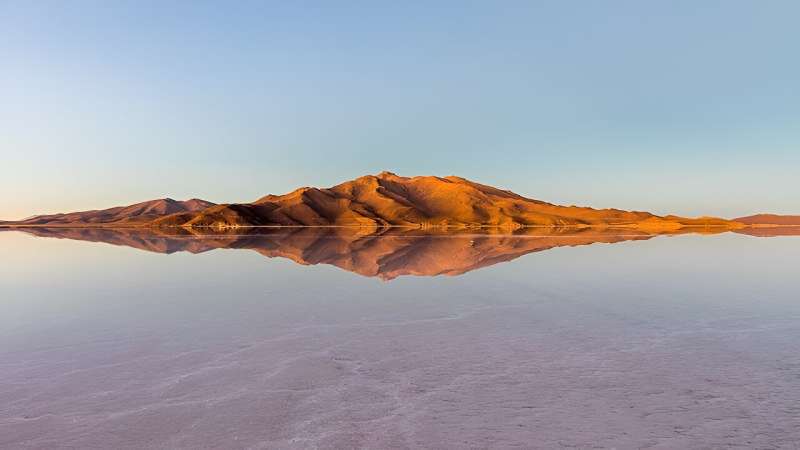This article has been reviewed according to Science X's editorial process and policies. Editors have highlighted the following attributes while ensuring the content's credibility:
fact-checked
trusted source
proofread
Bolivia's lithium is like white gold in the Salar de Uyuni

As the world undergoes the great energy transition—from fossil fuels to alternative energy and batteries—rare earth metals are becoming more precious.
Open The Economist, Forbes, or Fortune, and you'll see an article nearly every day on lithium, nickel, or copper. For investors seeking to profit off of the transition, lithium seems like a sure bet. Dubbed "white gold" for electric vehicles, the lightweight metal plays a key role in the cathodes of all types of lithium-ion batteries that power electric vehicles (EVs). Although EVs produce fewer greenhouse gases than gas- or diesel-powered vehicles, their batteries require more minerals, particularly lithium.
On Sept. 26, Duke's campus welcomed the first in a series of discussions on climate and energy diplomacy focused on the challenges and opportunities of mining and development in South America's Lithium Triangle. In a room crowded with curious undergraduate and graduate students alike, some lucky enough to have snagged a seat while others stood at the perimeters, three experts discussed the possible future of Bolivia as a major player in the global lithium market.
Duke Distinguished Professor Avner Vengosh, Nicholas Chair of Environmental Quality in the Nicholas School of the Environment, began by highlighting the staggering EV growth in 2020–2022: Sales of electric cars have more than tripled in three years, from around 4% of new car sales in 2020 to 14% in 2022. That number is expected to rise to 29.50% in 2028. Speaking of the critical element to EV production, lithium, Vengosh said frankly, "we don't have enough."
Lithium is mined from two major sources, Vengosh explained. The first is from hard-rock pegmatite, where lithium is extracted through a series of chemical processes. Most of these deposits are found in Australia, the world's biggest source. The second is from lithium-rich brines, typically found in Argentina, Bolivia, and Chile, also known as the "Lithium Triangle."
These brine deposits are typically found in underground reservoirs beneath salt flats or saltwater lakes. The Salar de Uyuni in Bolivia is the world's largest salt lake, and the largest lithium source in the world. It stretches more than 4,050 square miles and attracts tourists with its reflective, mirror-like surface.
A group of Duke students led by a Ph.D. candidate pursuing research on Bolivian lithium development recently traveled to Bolivia to understand different aspects of lithium mining. They asked questions including:
- How renewable is the lithium brine?
- Are there other critical raw minerals in the lithium-rich brines?
- What are the potential environmental effects of lithium extraction?
- What is the water footprint of the lithium extraction process?
- Is water becoming a limiting factor for lithium production?
The Duke team conducted a study with the natural brine in the Salar, taking samples of deep brines, evaporation ponds, salts from evaporation ponds, wastewaters, and the lithium carbonate. Vengosh said that "we can see some inconsistency in the chemistry of the water that is flowing into the chemistry of the brine."
This indicates that there is a more complex geological process in the formation of the brine than the simple flow of water into the lake. The team also confirmed the high purity of the lithium carbonate product and that there are no impurities in the material. Additionally, the Duke team found that the wastewater chemistry produced after lithium carbonate production is not different from that of the original brines. Thus, there are no limitations for recycling the water back to the Salar system.
After Vengosh shared the findings of the Duke research team, Kathryn Ledebur, director of the Andean Information Network (AIN) in Cochabamba, Bolivia and Dr. Scott MacDonald, chief economist at Smith's Research & Gradings and a Caribbean Policy Consortium Fellow, discussed Bolivia's lithium policy.
With the largest untapped lithium deposits in the world, Bolivia has constructed a pilot plan for their lithium production, but Ledebur highlighted that the biggest hurdle is scaling. Additionally, with a unique prior-consultation system in place between the central government and 36 ethnic and indigenous groups in Bolivia, natural resources are a key topic of concern and grassroots action. Ledebur said, "I don't see that issue changing any time soon."
Another hurdle is that Bolivian law requires that the extraction process is controlled by the state (the state must own 51%). Foreign investors have been hesitant to work with the central government, which nationalized lithium in 2008 despite, critics said, lacking much of the necessary technology and expertise.
Maxwell Radwin, a writer for Mongabay, writes, "Evo Morales, the former socialist president who served from 2006 to 2019, nationalized the industry, promising that foreign interests wouldn't plunder Bolivia's natural resources as they had in the past. Instead, he said, lithium would propel the country to the status of a world power.
"Morales didn't just want to export lithium, though; he wanted to produce batteries and cars for export. This complicated deals with potential investors from France, Japan, Russia and South Korea, none of which came to fruition because, among other things, they were required to take on YLB (the state-owned lithium company) as an equal partner."
Ledebur said, "At this point in time, the Bolivian government has signed three contracts… and I think things will fall into place."
Naysayers say that the Bolivian government hasn't done anything to take advantage of the massive market sitting beneath their Salars and that grassroot consultations don't work. Ledebur said, "I don't think that it's perfect, but it's happening."
Duke students will return to Bolivia with professor Vengosh next year to conduct more research on the lithium extraction process. Then, they'll be able to see the effects of this "happening" first-hand.

















